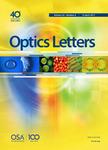版权所有:内蒙古大学图书馆 技术提供:维普资讯• 智图
内蒙古自治区呼和浩特市赛罕区大学西街235号 邮编: 010021

作者机构:Nankai Univ Inst Modern Opt Coll Elect Informat & Opt Engn Tianjin 300350 Peoples R China Nankai Univ Tianjin Key Lab Optoelect Sensor & Sensing Network Tianjin 300350 Peoples R China Nankai Univ Tianjin Key Lab Microscale Opt Informat Sci & Tech Tianjin 300350 Peoples R China Southern Marine Sci & Engn Guangdong Lab Zhuhai 519000 Peoples R China Tianjin Univ Sci & Technol Coll Elect Informat & Automat Tianjin 300350 Peoples R China
出 版 物:《OPTICS LETTERS》 (Opt. Lett.)
年 卷 期:2025年第50卷第2期
页 面:546-549页
核心收录:
学科分类:070207[理学-光学] 07[理学] 08[工学] 0803[工学-光学工程] 0702[理学-物理学]
基 金:National Key Research and Development Program of China [2023YFC3205803] National Natural Science Foundation of China [62231005, 62275131, 62105164, 12374353, 62305176] Tianjin Development Program for Innovation and Entrepreneurship Fundamental Research Funds for the Central Universities, Nankai University [63241330, 63241331, 63241446]
主 题:Field programmable gate arrays Multimode fibers Optical signals Optical transceivers Scintillation index Wavelength division multiplexing
摘 要:Free space optical communication (FSOC) technology can be used for data transmission between ocean islands as backup wireless communication networks to cope with traffic surges and emergencies. In this paper, we experimentally demonstrate the results of a 24-h real-time single-wavelength 2.5-Gbps FSOC between two islands 29 km apart at a low altitude with low complexity. On-off keying signals generated by field-programmable gate array (FPGA) board and commercial low-cost SFP + optical modules are employed as transceiver signals. At the receiving end, a 250-mm large-aperture Cassegrain telescope and 105-mu m multi- mode fibers (MMFs) are utilized to reduce the scintillation index from 1.5 to 0.48 and from 0.55 to 0.25 under strong and weak fluctuations, respectively. The averaged receiving optical power, scintillation index, and average bit rate error (BER) are experimentally observed over a 24-hour period with an averaged transmitting power of 36 dBm. The experimental results show that the proportions reach 93.737c and 99.97c for BER below 1 x 10-6 and 1 x 10-3, respectively. (c) 2025 Optica Publishing Group. All rights, including for text and data mining (TDM), Artificial Intelligence (AI) training, and similar technologies, are reserved.